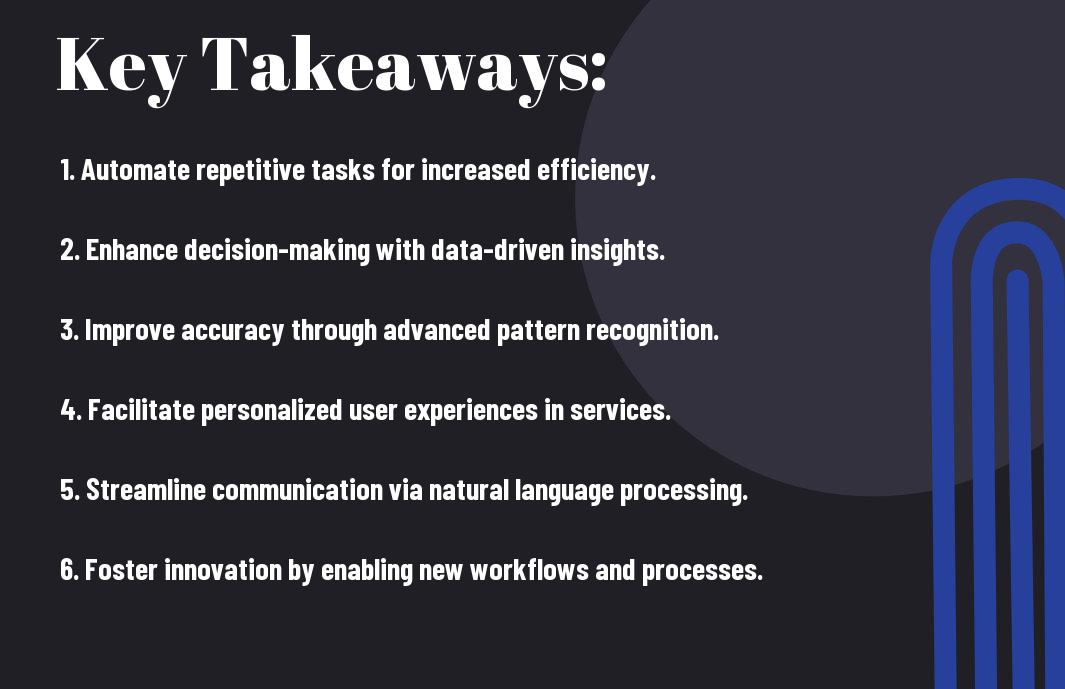Many businesses are witnessing a significant transformation in their operational workflows, thanks to the powerful capabilities of neural networks. By effectively automating processes and enhancing decision-making, these advanced algorithms are reshaping how you approach tasks and challenges in your work environment. In this blog post, you’ll explore the various ways neural networks are integrated into traditional workflows and how they can improve efficiency, accuracy, and overall performance in your organization. Join us as we research into the dynamic intersection of technology and business practices.
Key Takeaways:
- Automation of Tasks: Neural networks streamline processes by automating repetitive tasks, reducing the need for human intervention.
- Enhanced Decision-Making: They improve decision-making by analyzing vast amounts of data to provide actionable insights quickly and accurately.
- Adaptability: Neural networks can adapt to changing conditions and learn from new data, making workflows more flexible and responsive.
- Cost Efficiency: By optimizing operations, they contribute to lower costs and increased productivity in traditional workflows.
- Data-Driven Strategies: Neural networks facilitate the implementation of data-driven strategies, ensuring that decisions are based on empirical evidence.


Understanding Neural Networks
To comprehend the significance of neural networks in modern workflows, it’s imperative to explore their core functionalities and design. These algorithms are inspired by the neural connections in the human brain, capable of recognizing patterns and making decisions based on vast amounts of data. This results in incredible accuracy for various tasks, from image and speech recognition to predictive analytics.
Definition and Functionality
To define neural networks, think of them as systems of interconnected nodes that process information. Each node mimics a neuron, receiving inputs, processing them, and generating outputs. Neural networks learn from data to improve their performance over time, making them invaluable for automating complex decision-making processes.
Types of Neural Networks
To explore the types of neural networks, consider the following categories that serve varied applications:
- Feedforward Neural Networks
- Convolutional Neural Networks (CNNs)
- Recurrent Neural Networks (RNNs)
- Generative Adversarial Networks (GANs)
- Radial Basis Function Networks
Assume that understanding these categories will aid you in selecting the right neural network for your specific needs. Below is a comparative table of each type:
| Type | Description |
|---|---|
| Feedforward Neural Networks | Simple structure where data moves in one direction, primarily used for classification. |
| Convolutional Neural Networks (CNNs) | Specialized for processing grid-like data such as images, imperative in computer vision. |
| Recurrent Neural Networks (RNNs) | Designed for sequential data, enabling applications like language modeling. |
| Generative Adversarial Networks (GANs) | Utilizes two networks to generate new data instances, widely used in image synthesis. |
| Radial Basis Function Networks | Focuses on function approximation and interpolation tasks, suitable for numerical data. |
This understanding gives you the foundational knowledge to dive deeper into how neural networks transform traditional workflows. These types of networks enhance capabilities in various sectors, whether that’s in healthcare, finance, or manufacturing.
- Neural networks automate repetitive tasks.
- They improve accuracy by learning from data.
- They adapt and optimize workflows based on performance.
- They enable predictive analysis and decision-making.
- They offer personalized experiences for users.
Assume that integrating these technologies into your workflows can significantly enhance efficiency and innovation. Understanding their types and functions will allow you to leverage their strengths effectively.
Traditional Workflows
It is crucial to understand that traditional workflows refer to established processes and systems that have defined protocols for task completion. These workflows often involve sequential tasks, manual efforts, and a strong reliance on human judgment, which can lead to predictable outcomes but may restrict efficiency and adaptability. The integration of both human and technology resources shapes these workflows, resulting in varying degrees of productivity across different sectors.
Characteristics of Traditional Systems
Among the key characteristics of traditional systems are structured and documented processes, manual data handling, and reliance on hierarchical decision-making. Typically, you’ll find that traditional workflows emphasize consistency, predictability, and control, making it easier to follow established protocols while potentially limiting innovation and responsiveness to change.
Limitations and Challenges
Among the significant limitations and challenges are inefficiencies, slow response times, and difficulties in scaling operations. These factors can hinder your organization’s ability to adapt to changing market conditions, resulting in lost opportunities and reduced competitiveness.
To address these limitations, you may encounter issues such as resistance to change, the complexity of integrating new technologies, and the struggle for collaboration among various departments. Additionally, traditional workflows may be characterized by siloed information systems, leading to communication breakdowns and a lack of real-time data analysis. These challenges emphasize the need for more innovative approaches and solutions that utilize advanced technologies, such as neural networks, to enhance efficiency and agility in your workflows.
Integration of Neural Networks
Despite the challenges faced in adopting advanced technologies, the integration of neural networks into traditional workflows can redefine operational efficiency. By leveraging the capabilities of neural networks, businesses can enhance decision-making processes, improve accuracy, and ultimately achieve better outcomes. This integration facilitates a significant shift, allowing you to embrace innovative methodologies that streamline operations and drive performance.
Transformative Applications
Around many industries, neural networks are transforming applications ranging from customer service to data analysis. These advanced systems can analyze vast datasets to identify patterns and provide insights that were previously unattainable. As you harness these transformative applications, you enhance your workflow and gain a competitive advantage across different spheres of your business.
Automating Processes
Any organization looking to improve efficiency can benefit from the automation potential of neural networks. By adopting these technologies, you can minimize repetitive tasks, reduce human error, and allocate resources more effectively, allowing your team to focus on higher-value activities.
Even in complex workflows, the power of neural networks can simplify processes by automatically handling data entry, scheduling, and even customer engagements. This automation not only speeds up operations but also allows you to gather better insights from consistent data handling. With neural networks taking charge of these tasks, you can enhance productivity and create a more dynamic work environment, enabling your team to innovate and adapt swiftly to changes in the marketplace.
Impact on Efficiency
Once again, neural networks are redefining efficiency in various workflows. By automating decision-making processes, they minimize human error and enhance productivity. This impact is illustrated in studies such as Deep Learning and Neural Networks: Decision-Making …, which highlight how organizations are leveraging these technologies to streamline operations and achieve better outcomes.
Time Savings
Against the traditional methods that often require extensive manual input, neural networks can process vast amounts of data within seconds. This leads to significant time savings, allowing you to focus on other strategic tasks rather than spending time on repetitive, time-consuming processes.
Cost Reduction
Beside time savings, implementing neural networks can lead to substantial cost reductions. By optimizing workflows and reducing the need for human labor in certain functions, you can allocate resources more effectively, resulting in lower operational costs.
Even as neural networks automate routine tasks and improve accuracy, they free up your workforce to engage in more value-added activities, which can enhance overall productivity. This transition mitigates costs associated with errors or redeploying staff, ultimately improving your bottom line. Additionally, the scalability of these systems means you can adjust to demand fluctuations without incurring significant extra expenses.
Case Studies
Your understanding of neural networks can be enhanced by exploring various case studies that demonstrate their transformative impact on traditional workflows. Consider the following examples:
- Healthcare: A study showed a 30% increase in diagnostic accuracy using neural networks in radiology.
- Finance: Neural networks improved fraud detection rates by 50%, significantly reducing losses.
- Manufacturing: Predictive maintenance powered by neural networks decreased downtime by 20%.
- Retail: Personalized recommendation systems yielded a 25% increase in sales conversions.
For deeper insights, explore this resource on Artificial Neural Networks for Neuroscientists: A Primer.
Industry-Specific Examples
One noteworthy application of neural networks can be found in the energy sector, where predictive analytics optimized resource allocation resulting in a 15% reduction in operational costs.
Success Stories
About the various advancements achieved through the integration of neural networks, companies have reported remarkable outcomes. In logistics, one organization utilized neural networks for route optimization, leading to a 40% decrease in delivery times.
Further, these success stories highlight the potential of neural networks across diverse industries, driving efficiency and innovation. Organizations that have embraced this technology are not just transforming their workflows but also setting new benchmarks in productivity and performance that everyone can aspire to achieve.
Future Trends in Neural Networks
After analyzing current advancements, it is evident that neural networks will continue to drive significant shifts in traditional workflows. Enhanced processing capabilities and more refined algorithms will further integrate these technologies into various sectors, enabling automation and efficiency that were previously unattainable. As you adapt to these trends, you’ll find that your workflows can become more agile and responsive, ultimately improving productivity and innovation across your organization.
Emerging Technologies
By embracing emerging technologies, you will be equipped with the tools to harness the full potential of neural networks. Innovations such as quantum computing and edge AI are on the horizon, promising to significantly enhance real-time data processing and decision-making. As these technologies evolve, you can explore new applications that can lead to improved efficiency and transformative workflows within your industry.
Predictions for Workflow Evolution
Against the backdrop of rapid technological advancements, predictions indicate that workflows will become increasingly data-driven and adaptive. The integration of neural networks will likely lead to a more collaborative environment, where human decision-making is augmented by AI insights. This evolution will empower you to leverage data for strategic planning and real-time adjustments.
It is expected that workflows will not just adopt neural networks for efficiency but will undergo a profound transformation in their core principles. You can anticipate a future where tasks are seamlessly automated, and your role will shift towards strategic oversight rather than manual execution. With AI-driven insights at your disposal, your decision-making process will be bolstered by accurate predictions and analytics, ensuring that you stay ahead in an ever-evolving landscape. As these technologies mature, you will be better positioned to innovate and adapt to new challenges in the workplace.
Final Words
So, as you explore the integration of neural networks into your workflows, it’s vital to recognize their transformative impact on efficiency and decision-making. By automating routine tasks and providing insights through advanced data analysis, these technologies allow you to focus on higher-level strategic objectives. Embracing neural networks not only streamlines your operations but also enhances your ability to innovate and respond to market changes, ultimately reshaping how work is conducted in your field.